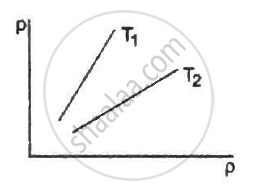Advertisements
Advertisements
प्रश्न
Two glass bulbs of equal volume are connected by a narrow tube and are filled with a gas at 0°C at a pressure of 76 cm of mercury. One of the bulbs is then placed in melting ice and the other is placed in a water bath maintained at 62°C. What is the new value of the pressure inside the bulbs? The volume of the connecting tube is negligible.
उत्तर
Here ,
`P_1 = 0.76 \text { m Hg }`
`P_2 = P`
`T_1 = 273 K`
`T_2 = 335 K`
Let each of the bulbs have `"n"_1` moles initially .
Let the number of moles left in second bulb after its pressure reached P be `"n"_2`.
Applying equation of state , we get
`(P_1V)/(n_1T_1)` = `(PV)/(n_2T_2)`
⇒ `0.76/(273n_1)` = `P/(335n_2)`
⇒ `n_2` = `(273P)/(335 xx 0.76)n_1`
Number of moles left in the second bulb after the temperature rose = `n_1 - n_2`
= `n_1 - (273P)/(335 xx 0.76) n_1`
Let `"n"_3` moles be left when pressure reached P . Applying equation of state in the first bulb , we get
`(P_1V)/(n_1T_1) = (PV)/(n_3T_1)`
⇒ `0.76/n_1 = P/n_3`
⇒ `n_3 = (Pn_1)/0.76`
`"n"_3` = its own `n_1` moles + the it received from the first
`"n"_3 = n_1+(n_1 - n_2)`
⇒ `(Pn_1)/0.76` = `"n"_1 + n_1` - `(273P)/(335 xx 0.76 )n_1`
⇒ `P/0.76 = 2 - (273P)/(335 xx 0.76)`
⇒ P = 0.8375
⇒ P = 84 cm of Hg
APPEARS IN
संबंधित प्रश्न
From a certain apparatus, the diffusion rate of hydrogen has an average value of 28.7 cm3 s–1. The diffusion of another gas under the same conditions is measured to have an average rate of 7.2 cm3 s–1. Identify the gas
[Hint: Use Graham’s law of diffusion: R1/R2 = (M2/M1)1/2, where R1, R2 are diffusion rates of gases 1 and 2, and M1 and M2 their respective molecular masses. The law is a simple consequence of kinetic theory.]
While gas from a cooking gas cylinder is used, the pressure does not fall appreciably till the last few minutes. Why?
Explain why cooking is faster in a pressure cooker.
Figure shows graphs of pressure vs density for an ideal gas at two temperatures T1 and T2.

The pressure of a gas kept in an isothermal container is 200 kPa. If half the gas is removed from it, the pressure will be
2 g of hydrogen is sealed in a vessel of volume 0.02 m3 and is maintained at 300 K. Calculate the pressure in the vessel.
Use R=8.3J K-1 mol-1
Figure shows a cylindrical tube with adiabatic walls and fitted with a diathermic separator. The separator can be slid in the tube by an external mechanism. An ideal gas is injected into the two sides at equal pressures and equal temperatures. The separator remains in equilibrium at the middle. It is now slid to a position where it divides the tube in the ratio of 1:3. Find the ratio of the pressures in the two parts of the vessel.
Use R=8.314J K-1 mol-1

Air is pumped into an automobile tyre's tube up to a pressure of 200 kPa in the morning when the air temperature is 20°C. During the day the temperature rises to 40°C and the tube expands by 2%. Calculate the pressure of the air in the tube at this temperature.
An air bubble of radius 2.0 mm is formed at the bottom of a 3.3 m deep river. Calculate the radius of the bubble as it comes to the surface. Atmospheric pressure = 1.0 × 105 Pa and density of water = 1000 kg m−3.
Is a slow process always isothermal? Is a quick process always adiabatic?
The initial pressure and volume of a given mass of a gas (Cp/Cv = γ) are p0 and V0. The gas can exchange heat with the surrounding. (a) It is slowly compressed to a volume V0/2 and then suddenly compressed to V0/4. Find the final pressure. (b) If the gas is suddenly compressed from the volume V0 to V0/2 and then slowly compressed to V0/4, what will be the final pressure?
A barometer tube is 80 cm long (above the mercury reservoir). It reads 76 cm on a particular day. A small amount of water is introduced in the tube and the reading drops to 75.4 cm. Find the relative humidity in the space above the mercury column if the saturation vapour pressure at the room temperature is 1.0 cm.
The human body has an average temperature of 98°F. Assume that the vapour pressure of the blood in the veins behaves like that of pure water. Find the minimum atmospheric pressure which is necessary to prevent the blood from boiling. Use figure for the vapour pressures.

The temperature and humidity of air are 27°C and 50% on a particular day. Calculate the amount of vapour that should be added to 1 cubic metre of air to saturate it. The saturation vapour pressure at 27°C = 3600 Pa.
Use R = 8.3 J K-1 mol-1
A bucket full of water is placed in a room at 15°C with initial relative humidity 40%. The volume of the room is 50 m3. (a) How much water will evaporate? (b) If the room temperature is increased by 5°C, how much more water will evaporate? The saturation vapour pressure of water at 15°C and 20°C are 1.6 kPa and 2.4 kPa respectively.
Use R = 8.3 J K-1 mol-1
If 1022 gas molecules each of mass 10-26 kg collide with a surface (perpendicular to it) elastically per second over an area of 1 m2 with a speed of 104 m/s, the pressure exerted by the gas molecules will be of the order of ______.
